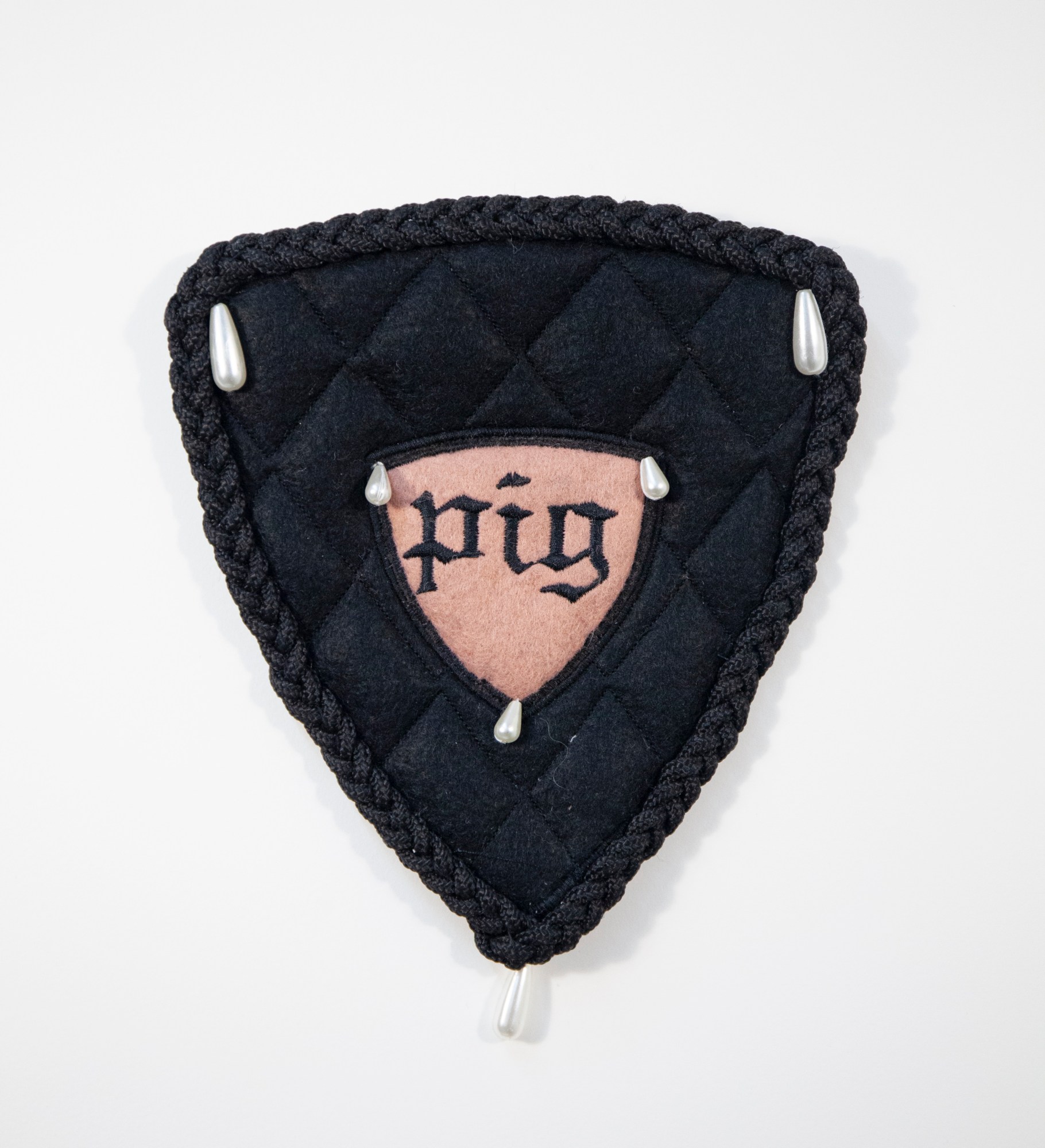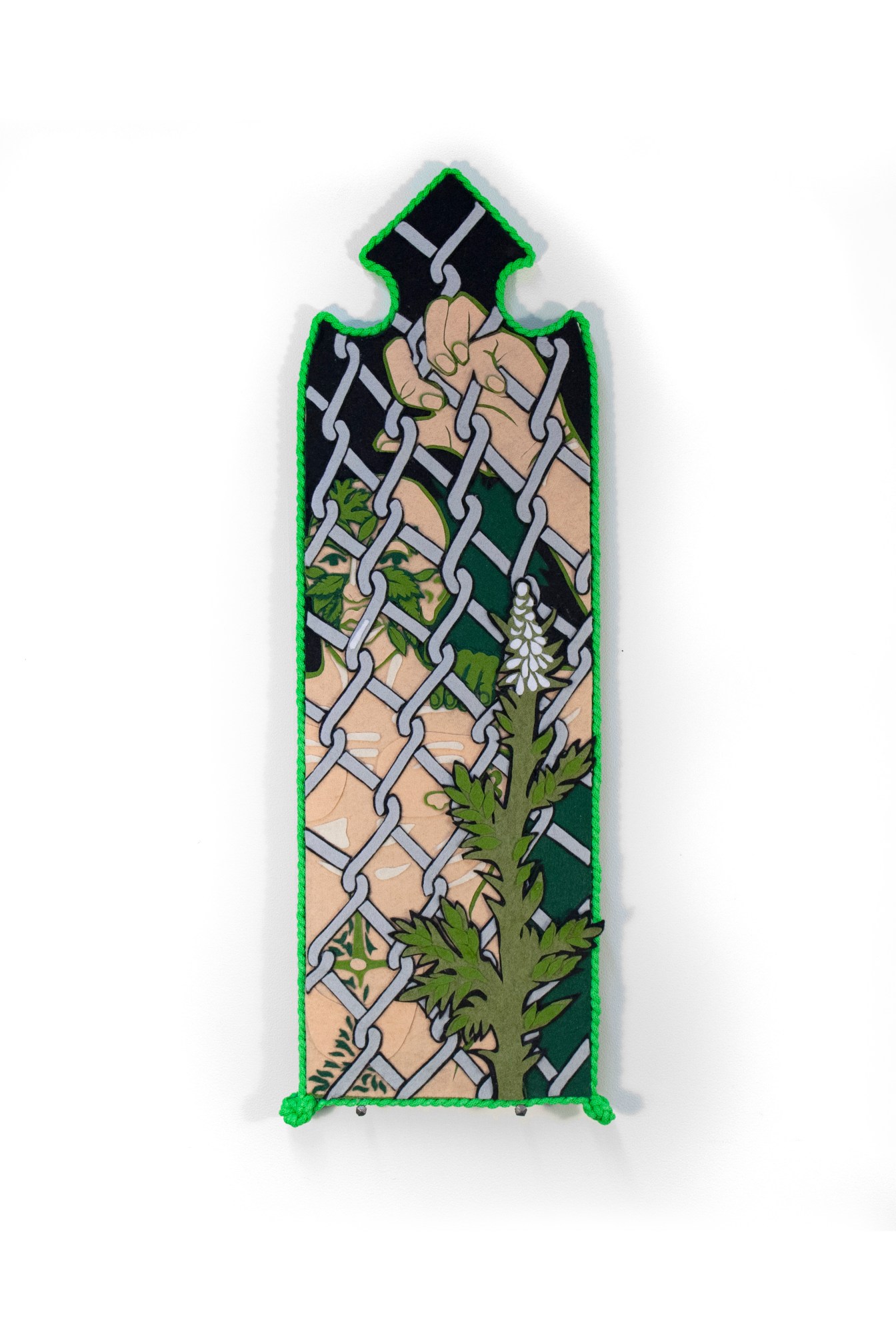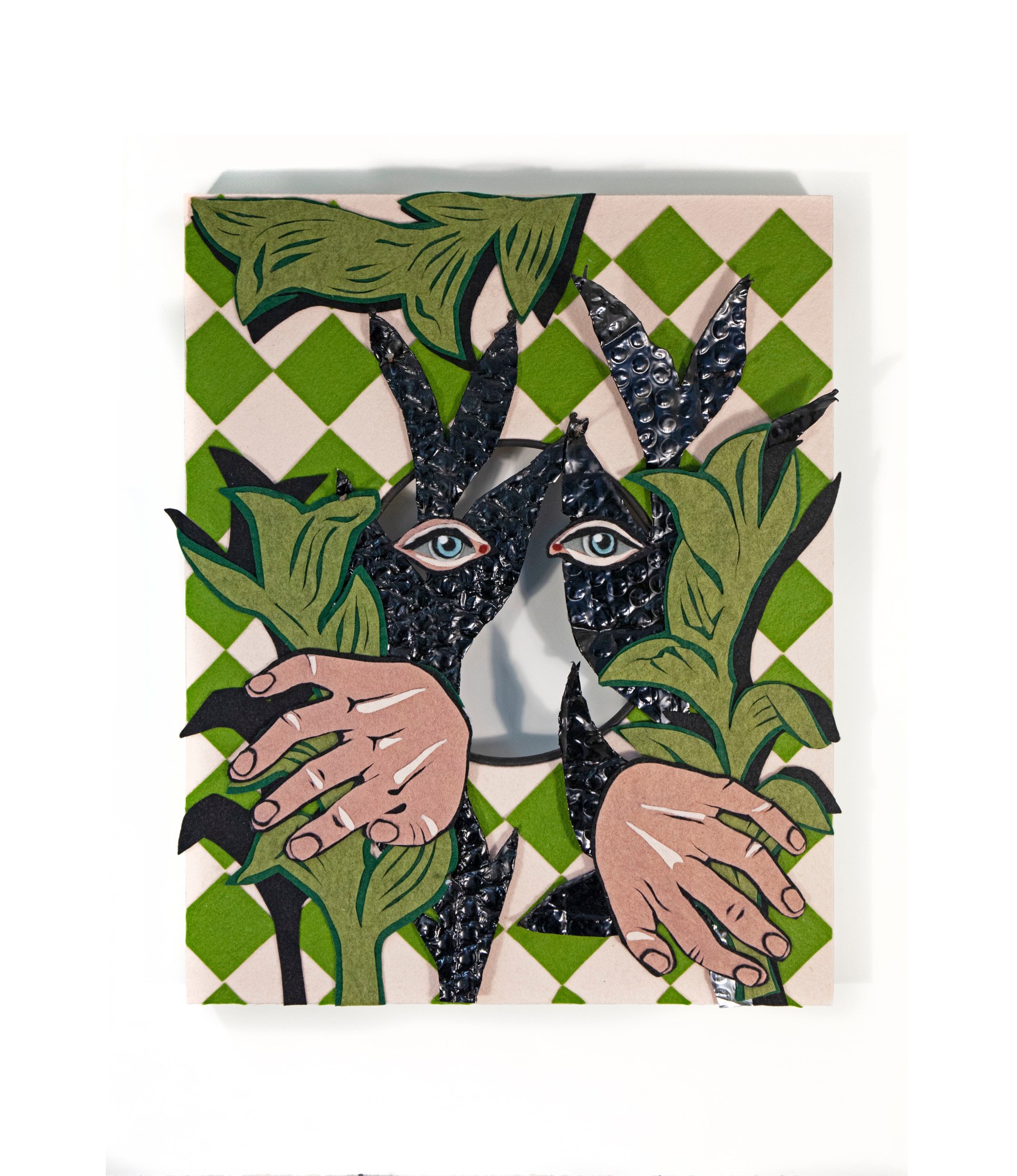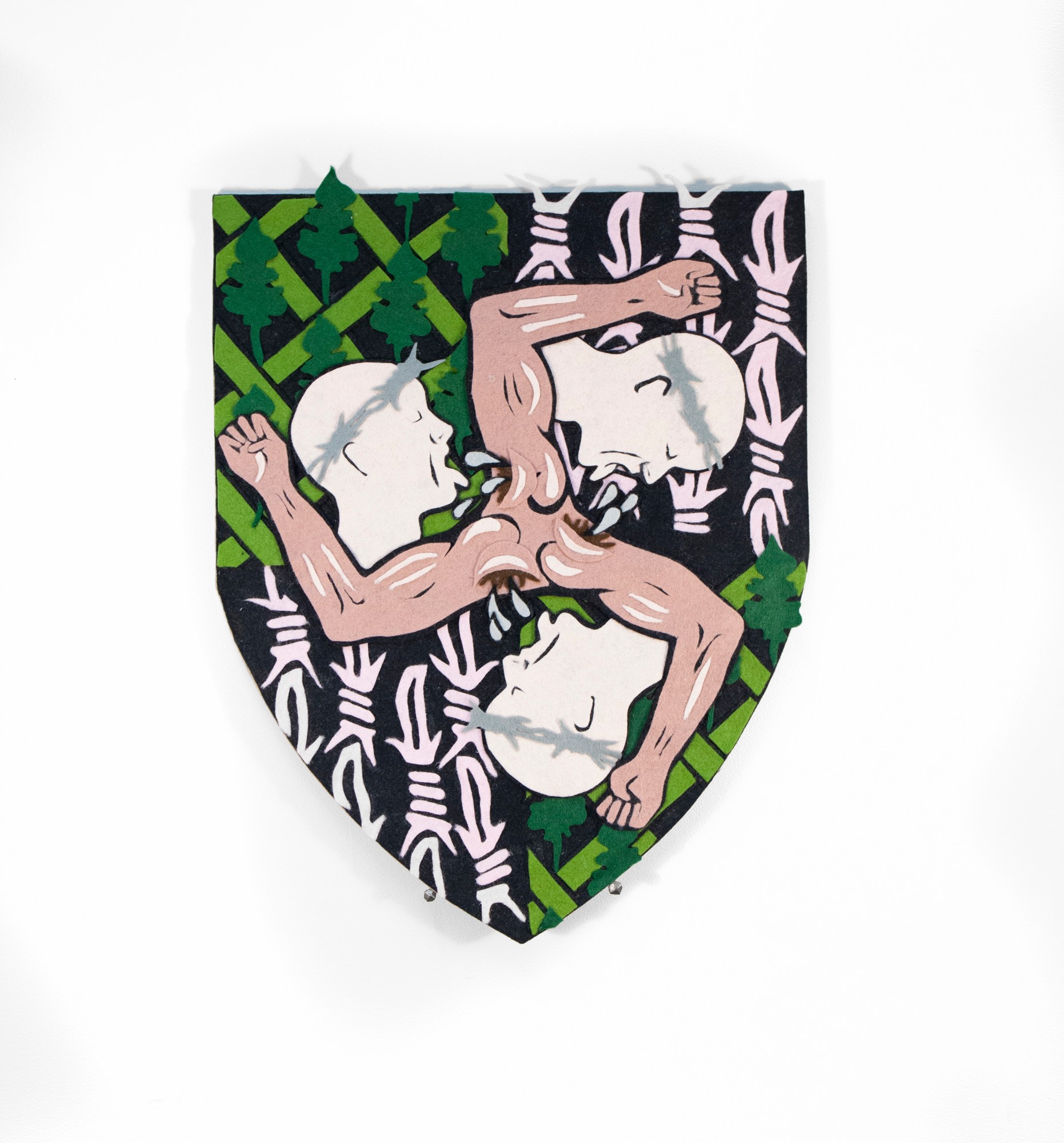Sat in his studio in London, artist and world-builder Jakob Rowlinson is surrounded by new work. Warping and weaving histories, he approaches the past with a camp humour that intermixes heraldry and hagiography with haemorrhoids and Grindr tribes. “The medieval imagination was fascinated by the anus,” Jakob tells me, as he unboxes a work from his upcoming show in Margate. Symbols combine and align, giving a contemporary voice to historical imagery rendered in reams of rich felt; fleshy pink tones set within a palette of bucolic greens, cut through (or perhaps constrained) by framing devices in cord and leather.
His work becomes a queerness — an ongoing reinterpretation and subversion of a visual language we are all aware of in different ways. On the morning we meet, somewhere between the Holborn Viaduct and St. Paul’s Cathedral, it’s his hands that I am drawn to — both those of the artist himself and those on the walls. In his collage work, hands and bodies are especially alive — with felt fingertips and sinewy limbs undercut by a dramatic textural tone. “I tend to focus on depictions of hands because so much emotion and meaning can be explained through gestures without being restricted to specific notions of gender or sexuality.”

Milky highlights on knuckles are counterposed with dark nail beds — bleeding, curling or clawing their way out of the frame — reaching out at the viewer or touching other flesh (like the penetrating finger of St. Thomas into the wound of Christ). For Jakob, these hands speak to a coding that has been transferred between generations. “When I see a video recording of myself, I become very aware of the hand gestures I am making, and how the campness of my limp wrists, or the curl of a particularly expressive gesture, makes me part of a larger archive of learned gestures and expressions that have been passed down through generations of LGBTQIA+ people.”
All this is set against the backdrop of the natural world, either alluded to in moss-green backdrops — with the felt conjuring an organic texture — or invoked through atlas moths and ferns, thorns and hooded kestrels. The kestrels are historically a symbol of status, but again Jakob’s investigative practice finds double meanings. “I want to reclaim the cultural landscape of ‘nature‘ away from its implied heteronormative focus (and mythologising language such as ‘mother’ nature), and to include representations which avoid the nature vs nurture [and] straight vs gay dichotomy.”

This interest in ecology not only chimes with contemporary climate discourse but echoes concerns shared by a long lineage of queer artists — from the medieval mystic visions of Hildegard of Bingen, through to those of Derek Jarman. In Sneaky Peak, a new work, cruising eyes peer out in bright blue from amidst green foliage and shady, mottled ferns — darkly unfurling in bubble wrap coated in black tar. I think of Derek Jarman’s film Blue (1993), an odyssey of gay mirth, mysticism and memory, which opens with the invocation: “You say to the boy open your eyes / When he opens his eyes and sees the light / You make him cry out. Saying / O Blue come forth / O Blue arise / O Blue ascend / O Blue come in.”
Referring to Biological Exuberance, a seminal text in which Bruce Bagemihl outlines over 400 species of animals that engage in same-sex behaviour, Jakob describes how “our understanding of the natural world is perceived through the lens of heteronormativity, and the public consciousness imagines animals, plants, landscapes and the animal kingdom as being fundamentally straight, and that queerness is something man-made”. Much as the landscapes of his work so often meld codes and signifiers — natural habitats and bodies simultaneously caged and transgressing — the soft textile of his work is often taken elsewhere by structural framing elements. Set on board, encased in decorative braid, quilted, suspended amidst wire-bound frames, or draped in chains. Invested with nods to kink play — an embroidered ‘Pig’, white beads in viscous drops, the hooded masks of the kestrels — the historical references become infused with a contemporary grit.

Heraldic pattern becomes a nod to codes of masculinity; “in many of my heraldry-inspired pieces, I exaggerate the decorative patterns derived from medieval designs in order to draw attention to this flamboyance and the ‘effeminate’ traits of medieval masculinity,” Jakob says. These patterns take on a new life in hot pink felt — becoming a backdrop to flayed, erotic bodies or languid limbs shedding scarlet drops of blood — beaded and celebrated and gesturing towards the viewer. “As a tradition, heraldry contains many complex instructions that vary from region to region, but one universal theme is to include ‘marks of dishonour’, typically for men who behaved unconventionally or whose lineage somehow made them less than ideal.” Reinterpreting these motifs amidst fecund landscapes and bodies in action, Jakob reclaims these historic codes as a mark of difference and defiance. “For example, the symbol for illegitimacy — which I consider to be a very queer idea, in that it disrupts the idea of reproduction and heteronormativity — is known as a ‘bend sinister‘, and has become a repeating motif in my work.”
The hybridity of Jakob’s work is a testament to his source material and to the medieval multiplicities that have fascinated him since he was a child. One particular reference point is the Gorleston Psalter — a 14th-century manuscript produced in Norfolk and now in the collection of the British Library — “because it contains so many stunning illustrations, called marginalia, of hybrid creatures and depictions of medieval life,” he says. “Aside from their obviously beautiful and mysterious qualities, what struck me most about these images was how queer they were.” This flexibility of reference and interpretation is in many ways the cornerstone of Jakob’s practice, taking a language and bending — or literally ‘queering’ — its meaning.

Reflecting on his work, which resonates not only in the studio but across the internet, he notes the way in which marginalia often blended “different genders, bizarre animals, and playing with sexual references in an incredibly fluid manner […] in many ways, marginalia therefore operate like memes.” From the psalters of the past through to the annals of Instagram, Jakob’s work is a pilgrimage leading us from the catacombs to the cruising ground — towards a contemporary queer body that is endlessly shape-shifting and decoding itself.
‘Visions of a Whispered Past’ opens at Quench Gallery, Margate, on Saturday 28th August
Credits
All images courtesy of Jakob Rowlinson


